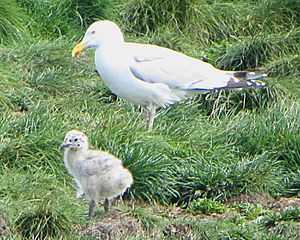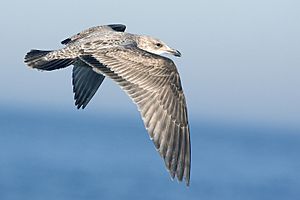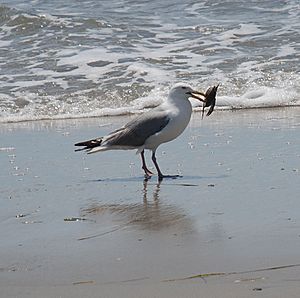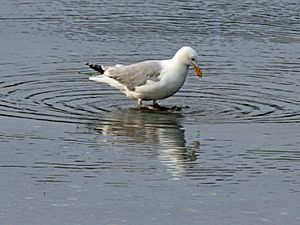American herring gull facts for kids
Quick facts for kids American herring gull |
|
|---|---|
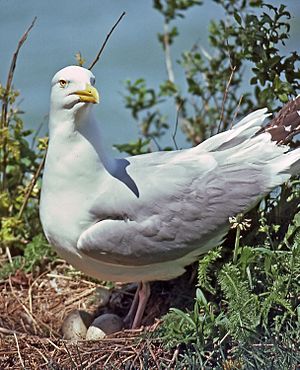 |
|
| Adult on nest | |
| Conservation status | |
| Scientific classification | |
| Genus: |
Larus
|
| Species: |
smithsonianus
|
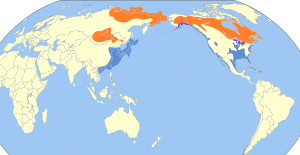 |
|
| Synonyms | |
|
Larus argentatus smithsonianus |
|
The American herring gull is a large gull found in North America. It's also sometimes called the Smithsonian gull. Some scientists think it's its own species, Larus smithsonianus. Others consider it a type of herring gull (Larus argentatus smithsonianus).
Adult gulls have white bodies, gray backs and wings. Their wingtips are black with white spots. They also have pink legs. Young gulls are gray-brown. They look darker and more even in color than European herring gulls. They also have a darker tail.
These gulls live in many different places. You can find them near coasts, lakes, and rivers. They also visit garbage dumps. They eat many things, like invertebrates and fish. American herring gulls usually nest near water. They lay about three eggs in a simple nest on the ground.
Contents
Understanding the American Herring Gull's Name
This gull was first described in 1862 by a scientist named Elliott Coues. He studied specimens from the Smithsonian Institution. That's why it's sometimes called the Smithsonian gull. The name smithsonianus honors James Smithson. He was an English chemist whose gift helped start the Smithsonian Institution.
Later, scientists decided it was a subspecies of the herring gull (Larus argentatus). The word Larus comes from Latin. It means a gull or a large seabird.
The way scientists group gulls is quite complex. A study in 2002 suggested the American herring gull might not be closely related to European herring gulls. Some groups, like the Association of European Rarities Committees, now see it as a separate species. However, the American Ornithologists' Union still considers it a subspecies.
What Does the American Herring Gull Look Like?
This is a big, strong gull. It has a powerful bill, a full chest, and a sloping forehead. Male gulls are usually 60 to 66 centimeters (24 to 26 inches) long. They weigh between 1050 and 1650 grams (2.3 to 3.6 pounds). Females are a bit smaller. They are 53 to 62 centimeters (21 to 24 inches) long. They weigh 600 to 900 grams (1.3 to 2 pounds). Their wings can spread wide, from 120 to 155 centimeters (47 to 61 inches).
Adult gulls ready for breeding have white heads, rumps, and tails. Their undersides are also white. Their backs and upper wings are pale gray. The tips of their wings are black with white spots, like "mirrors." The back edge of their wings is white. Their legs and feet are usually pink. Sometimes they can look bluish or even yellow. The bill is yellow with a red spot on the lower part. Their eyes are bright yellow, with a yellow or orange ring around them. In winter, their heads and necks have brown streaks.
Young gulls need four years to get their full adult plumage (feathers). They change their look several times during this period. First-year birds are gray-brown with a dark tail. They have dark eyes and a dark bill. Second-year birds often have pale eyes and a pale bill with a black tip. They also start to show gray feathers on their backs. Third-year birds look more like adults. But they still have some black on their bill and brown on their body and wings. They also have a black band on their tail.
What Sounds Do They Make?
American herring gulls don't sing. Instead, they make many different cries and calls. Their "long call" is a series of notes. During this call, they dip their head then raise it. The "choking call" is used when they are trying to attract a mate. It's also used when they are defending their territory. Young gulls make high-pitched cries. These cries are to get their parents to feed them. They might also make a clicking sound if a parent suddenly flies away.
How Are They Different from Similar Gulls?
Adult European herring gulls look very much like American herring gulls. However, some European types are smaller. Others are typically darker gray on top. European birds don't have the long gray marks on certain wing feathers. They also lack solid black marks that American herring gulls have. Young European birds in their first winter look more checkered. They also have more streaks on their undersides. Their rump and the base of their tail are paler.
Where Do American Herring Gulls Live?
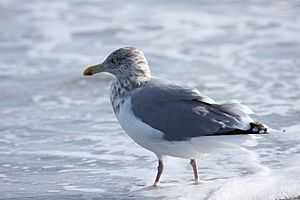
These gulls breed across northern North America. Their breeding areas stretch from central Alaska to the Great Lakes. They also breed along the northeast coast of the United States. This includes areas from Maine south to North Carolina. They breed in most of Canada, except for the southwest and Arctic regions.
Many gulls stay all year in southern Alaska, the Great Lakes, and the northeast USA. But most gulls fly south for winter. They go as far as Mexico. Small numbers even reach Hawaii, Central America, and the West Indies. Sometimes, a few gulls travel far from their usual areas. These "vagrants" have been seen in Colombia and Venezuela. There are also reports from Ecuador and Peru. The first time one was seen in Europe was in 1937. It was a bird from New Brunswick caught on a boat near Spain. Since 1990, more have been seen in Western Europe. The first one in Britain was in 1994.
They usually build their nests in groups. These groups are called colonies. They nest near water, on coasts, islands, and cliffs. Some even nest on rooftops in cities. They find food at sea, on beaches, and in muddy areas. They also feed in lakes, rivers, fields, and garbage dumps. They rest in open areas close to where they feed.
How Do American Herring Gulls Behave?

What Do They Eat?
American herring gulls eat many different things. Their diet includes sea invertebrates like mussels, crabs, and squid. They also eat fish like capelin and smelt. Insects are also on their menu. They even eat other birds, including their chicks and eggs. They often feed on dead animals (carrion) and human trash.
They pick food from the surface of the shore or sea. They can also dip underwater or dive shallowly to catch food. They are known to eat clams and mussels. They drop these shells from a height onto hard surfaces like roads or rocks. This breaks the shells open so they can eat the soft parts inside. Scientists are still studying if this behavior is learned or if they are born knowing how to do it.
How Do They Reproduce?
Pairs of gulls form in March or April. Their nest is a simple hollow in the ground. They line it with plants like grass, seaweed, and feathers. Usually, they lay three eggs over four to six days. The eggs are about 72 millimeters (2.8 inches) long. They can be different colors, with brown marks on a pale blue, olive, or cinnamon background.
The eggs are incubated (kept warm) for 30 to 32 days. This starts when the second egg is laid. The young birds learn to fly after 6 to 7 weeks. They are fed in the nest area for several more weeks. Their parents continue to care for them until they are about 6 months old. Both parents help build the nest. They also take turns keeping the eggs warm and feeding the young.
Some gull pairs stay very close all year. They watch out for each other. Other gulls are more independent. But they might still choose the same mate each spring.
How Are American Herring Gull Populations Doing?
During the 1800s, this species became quite rare. People hunted them for their eggs and feathers. From the 1930s to the 1960s, their numbers grew quickly. This was because they were protected from hunting. Also, there was more waste from fishing boats for them to eat. And there was less competition for small fish. This was because humans had reduced the numbers of large fish, whales, and seals.
The American herring gull was also affected by the chemical DDT. A study on this gull was the first to show that DDT made eggshells thinner. Their population growth slowed down in the 1970s and 80s. Their numbers might even be going down in some areas now.
See also
 In Spanish: Gaviota argéntea americana para niños
In Spanish: Gaviota argéntea americana para niños



